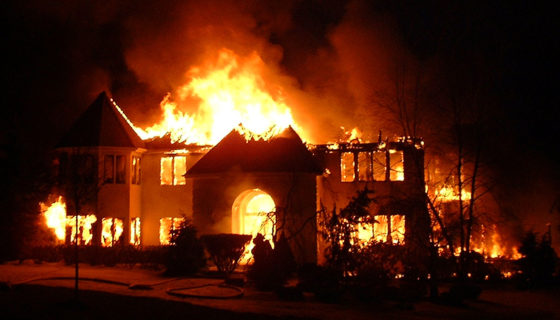Dealing With Violent Confrontations
Dealing With Violent Confrontations
If you’ve been following our articles here at ITS Tactical, you’ve no doubt heard my good friend Jack of The Survival Podcast being mentioned.
I was invited by Jack on Monday, to take part in the filming of the Advanced Ballistic Striking DVD Series that he and his business partner Neil are producing. They flew Systema (Russian Martial Art) expert Val Riazanov in from the UAE to film the DVD’s, and I was asked to assist Val during the weapons disarming portion.
Assisting Val basically meant drawing weapons on him, getting disarmed and thrown to the floor. I’ve trained in Systema before, a few years back when I lived in California, but have never trained with anyone quite like Val.
I learned an incredible amount of information in just the few hours I spent with him Monday, and would like to take this opportunity to share some of that knowledge. I’m also going to heavily note the incredible Podcast that Jack put together that prompted me to write this article of the same headline.
I’d like to encourage every one of you to get over and listen to Jack’s Podcast from yesterday. I feel this is one of his best and most applicable podcast’s to what we do here at ITS.
Violence
I’m a strong believer that violence is inherent in human beings, we see it everyday in the news, we see it everyday on the streets, and most of us who commute on a regular basis see it daily.
Violence can be as small as the verbal altercation you got in with the guy who stole your parking space, and as large as genocide where millions are killed. The point I’m trying to make is that you have to recognize that violence surrounds us, and you have to be prepared to handle violent situations accordingly.
By handling them accordingly, I mean not having to handle them in the first place.
Recognition
Before we get into how to keep yourself out of these situations, let’s first talk about how to recognize that you’re in one. It’s not always going to be outwardly apparent that you’re even in a conflict until its too late, but by learning how use your situational awareness, trust your gut and learn what to look for, you’ll be that much more prepared.
The primary tool at your disposal for recognizing a conflict is your gut. I’ve always felt that if you can’t trust your gut, then you’ve got big problems. Trusting my gut has saved me from more than one dangerous situation in my life, and I truly believe that it’s the only thing you can truly 100% count on in your life. Your gut will tell you when its not a wise move to walk through that door, or start an argument with the guy who just cut you off in traffic. Ignoring this can never be a good thing.
Secondary in your toolbox is situational awareness, which is paying attention to everything around you at all times and keeping your head on a swivel. This means being aware of absolutely everything. Who poses the biggest threat when you’re sitting down to eat in a restaurant, where the exits are, where can you take cover if something goes down, and especially who’s behind you. I almost never sit with my back towards the ingress of traffic anywhere I go, and if I do wind up in that situation, I’m always checking my six. It’s something my wife gripes at me about, but I always want to put myself in the best position to see a threat coming at me.
Situational awareness also means being aware of ALL potential threats. Does this guy that’s running his mouth in front of me have buddies that are moving up to join him? To quote my friend Dion from SCG International, you should be thinking about three things. Buddies, weapons and options. Where are your buddies and where are your opponent’s? What can you use as a weapon if needed, and what’s in your opponent’s hands? And lastly, what are your options for escape as you’re always looking for the door.
Finally we get to body position, which Val mentioned was something that everyone knows how to assess for a threat. He’s absolutely right, I’ve known how to recognize a threat by looking at a person’s body position for a long time now. He was able to relate this extremely well as we were filming, by demonstrating different body positions and asking me what my natural reaction was to these.
During a violent situation, the aggressor will roll their shoulders up and forward, most likely tighten their fists, and their demeanor will shift. We’ve all seen this first hand, and these telltale signs are some of the first things that occur during a violent situation. As Val also mentioned, the absence of these telltale signs, can produce some of the most scary situations. Someone that approaches you with a smile and a handshake can just as easily be the person who draws a knife with their other hand and plunges it into your liver.
By recognizing these signs before there’s a chance for violence, you’ll be better prepared to not only avoid them for yourself, but for all those around you as well.
Avoidance
Avoidance is not putting your head in the sand and pretending that you can will away violent situations. They can and will happen to every one of us at some point in our lives. It’s how you handle those situations that is important.
During my filming with Val, he made some tremendous points about not only avoiding conflicts, but defusing a violent situation. Let’s take a shopping mall, you’re walking through the mall with your family when a rough looking gang-banger shoulders you while you’re walking past.
Do you turn around, tighten your fists and scream some obscenities at him? If I would have been asked that question 10 years ago, I would have said “Damn right!” That’s just how I was raised, not by my parents, but by my own code. I never wanted to allow myself to appear weak, scared or incapable of defense.
This had a lot to do with how I was treated as a youngster. I had a lot of so-called friends in my pre-teen years and while I wasn’t beat up on physically, I was beat up on emotionally. Constantly picked on by friends and stolen from as well. I had friends that even broke into my house while I wasn’t home to steal my things.
It wasn’t until I got to be around 12 or so that I finally distanced myself from these people, who knows why it went on as long as it did, but the important thing is that I recognized it and moved on. As I grew up I chose my friends very carefully and developed a real innate sense of trust recognition. I still feel to this day that my experiences as a kid really helped to allow me to recognize a trustworthy person and who I choose to associate with.
My point behind this tangent is that I grew up feeling like I had to prove something. Constantly looking for an altercation, I definitely found them in my teens and early 20s. I don’t necessarily mean fist fights or even violent situations, but I’m a firm believer in the vibe that you send out, comes back to you. My buddy Mil-Spec Monkey has a patch that sums this up pretty well “Shit Magnet.”
I’m actually really lucky that nothing happened to me during that time in my life, because I wasn’t trained to deal with it. It wasn’t until I went into the Military that I realized the error of my ways. As I became empowered from my training in the Military, coupled with a good friend who introduced me to Systema, I began to realize the need to be discreet with what I knew. To never outwardly appear as though I knew what I was doing, unless absolutely necessary.
The goal is to stay relaxed and appear harmless. To quote Teddy Roosevelt, “Speak softly and carry a big stick; you will go far.” Speaking softly means just that, not raising your voice, not appearing agressive, etc. That big stick Roosevelt refers to is your training, having the means to inflict damage only when necessary. It doesn’t mean you wear that training on your sleeve or expose it at the wrong time.
You also have to keep in mind that it’s not always just you in these situations. What I mean by that is that you have to take into consideration that your actions affect the loved ones that may be with you when your confronted with violence, or the friends of yours who aren’t trained to defend themselves. These people depend on you to be the stronger person, and will look to you for guidance.
Defusing
Defusing a situation doesn’t necessarily mean that you’re truly even in a conflict yet, but can mean the difference between one escalating to that level. So for instance, take the gang-banger that just ran into your shoulder in the mall. If your situational awareness was less than optimal and you never saw it coming, a simple “I’m sorry about that, I didn’t see you” is all you need to say. Be the quiet professional and don’t get hung up on your ego.
If a conflict does make a turn for the worse, the best thing you can do is to continue to defuse the situation. If mere words aren’t slowing down this gang-banger, and he’s downright pissed that you were walking too close to him, taking a non-threatening stance is imperative. Again, staying relaxed and appearing harmless, which is also a fighting stance in many combative programs and Systema.
For example, if I was a passerby to the situation of the gang-banger getting in your face and I saw him clenching his fists, raising his shoulders and taking a traditional fighting stance, I’d assume he was the aggressor. Especially if I saw you holding your hands up in front of you, open-palmed, telling him to calm down or down by your side backing away from him. Both of these are the fighting stances I mentioned.
Going on the offensive might not always be the best course of action though, sometimes compliance can be the best option. Let me sum up the kind of compliance I’m talking about with this quote from Sun Tzu:
“All warfare is based on deception. Hence when able to attack, we must seem unable, when using our forces, we must seem inactive; when we are near we must make the enemy believe we are far away; when far away we must make the enemy believe we are near. Hold out baits to entice the enemy. Fein disorder, and crush him.”
With compliance, you’re using deception to gain the tactical advantage. For instance, in a kidnapping scenario your captor has already managed to bind you in zip ties. Knowing the techniques we’ve taught here at ITS, you know that these things are no match for you and you’ll easily be able to escape. What you don’t want to do though is to expose your tell before you have the best opportunity to break free. In other words you don’t start maneuvering the zip tie’s locking mechanism to the optimal place to break it while your kidnapper is looking.
Jack made a very good point in his show, in that our western world athletes train to win. The russian philosophy is to train to survive. By being merely surviving and being patient your opponent will present a weakness, and in that weakness you find the opportunity for victory.
Lethal Force
Everything goes out the window when you’re confronted with lethal force such as a knife or in particular, a gun. As Val puts it, you no longer have a choice on whether to defend yourself or not, and I definitely agree. Even if you comply with your aggressor’s demands you could still wind up dead.
Are there situations where complying could allow you to fight again another day? Sure, but my opinion, and this again is my opinion, why risk it? If that mugger that’s demanding your wallet with a gun pointed towards you has nothing to loose, what makes you think that he won’t just kill you after he gets what he wants? It happens all the time.
We’ve mentioned the use of a giveaway wallet before to add into your EDC (every day carry), and this is one of the few options for compliance that could benefit you in this situation. There’s not a high likelyhood that the mugger is going to shoot you before he gets what he wants, and depending on the situation, could give you the advantage you need to decrease the distance to disarm him or go to your own weapon. This of course is with proper training, which I hope I’ve made a strong case for by now.
Speaking on decreasing the distance, let me take this opportunity to mention what Val refers to as the “Critical Distance.” This is a range of 4 to 6 feet, or beyond arm’s reach. Why this is referred to as the critical distance, is that anything closer than this, and there’s an opportunity to disarm an attacker with a gun. Further than this distance and there’s a chance to move out of the line of fire or get off the X. You may even get shot at this further distance, but you’re less likely to take a lethal shot.
When we were filming disarms with a gun, I was amazed at how quickly Val could move out of the line of fire at this greater distance. Before I brought the weapon up to shoot he was off the X. Within the critical distance though, even an untrained individual with a gun can do damage to a professional before they can react.
Speaking of disarms, we had a Remington 870 shotgun that Val was using to demonstrate buttstock strikes after takeaways on a heavy bag, and let me just say this. An 870 stock will break during a strike. Jack wasn’t too happy to see his stock break in two, and all Val could say is “That doesn’t happen with AKs.”
Closing Notes
This should have been mentioned with avoidance, but always remember that as soon as you draw any weapon you’ve now put yourself in the position to deal with Law Enforcement and any potential concealed carry holders that could be observing the altercation you’re in. You have to take that into consideration and the potential to be mistaken as the aggressor in the situation.
I’d also like to reiterate some things Jack mentioned in his show, that I really feel everyone needs to understand. If you’re a concealed carry holder, or even if you carry a knife for a weapon, you have to be 100% ready to use deadly force without hesitation if required. The odds are also against you unless you’re properly trained.
You have to assume that the person posing an imminent threat to you has no morals, and will take everything up to and including your life. The law requires us to think twice before using deadly force, and while you should, it could mean your life.
Q&A
We’re going to do a Q&A with Val via email, and I’d like you guys to send in any questions you might have for him about Systema or anything else for that matter. I’ll submit the 10 best questions to him to be answered in an upcoming post.
Also, let’s get some conversation going in the comments, let me know your thoughts to this article and what your take is on the topics I’ve mentioned.
Update: The Advanced Ballistic Striking DVD Set has now been released!











Discussion